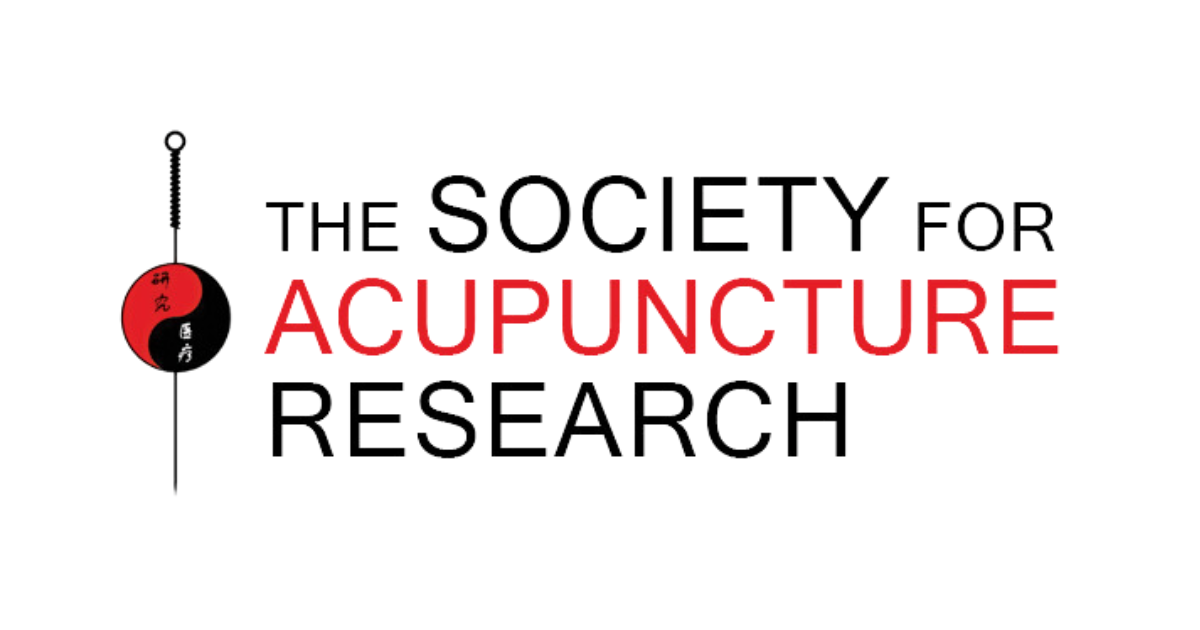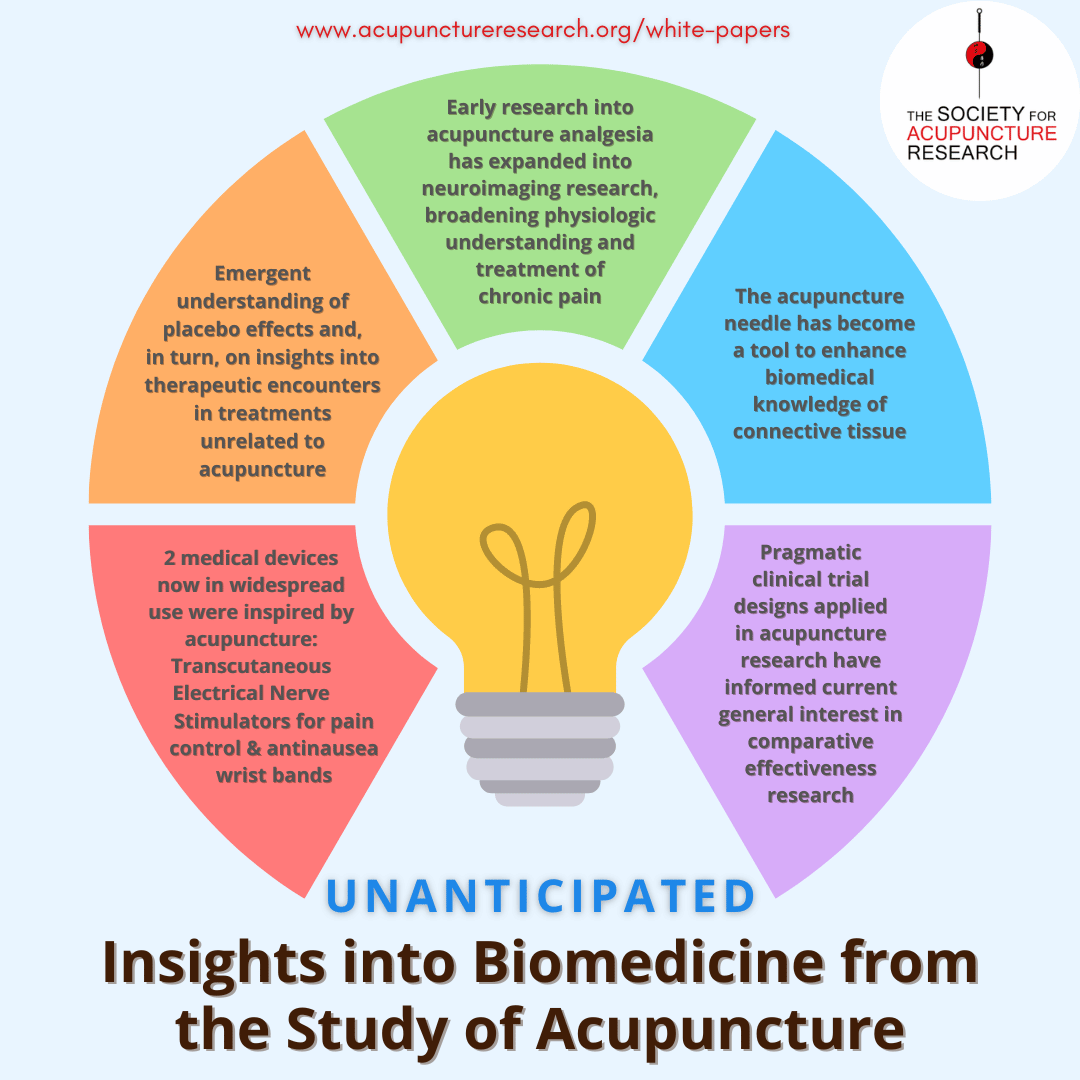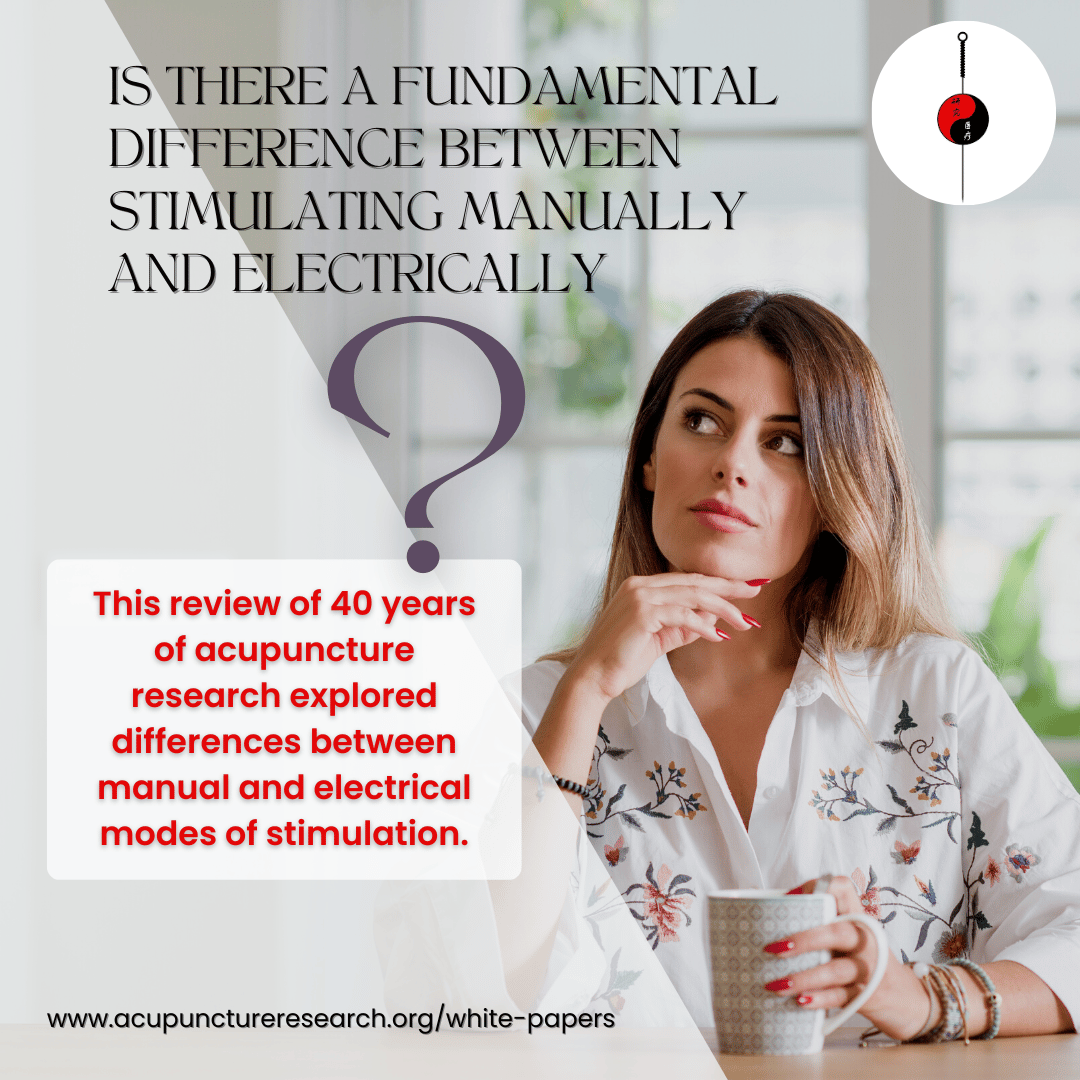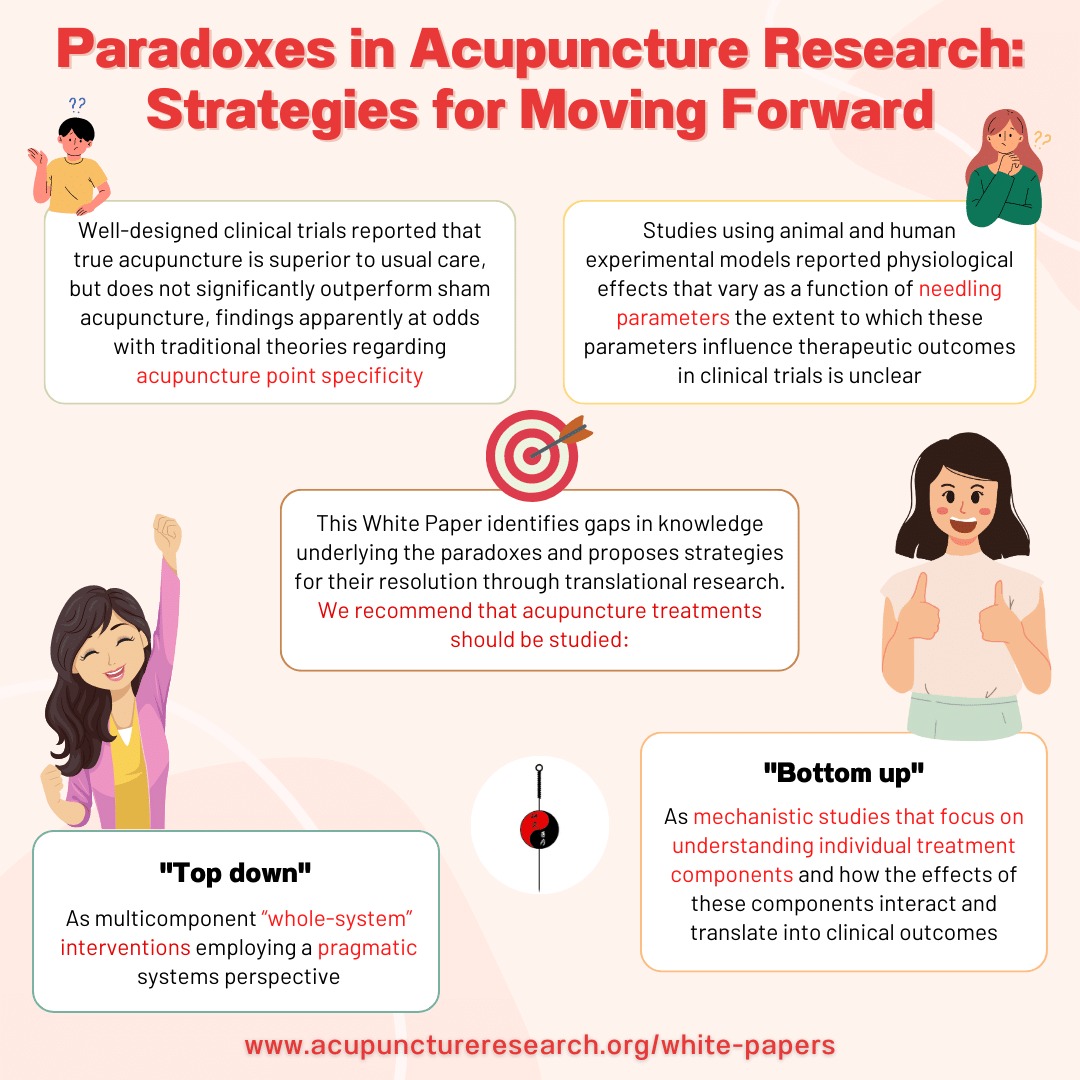White Papers by SAR
SAR's White Papers are the published result of periodic think-tank retreats where SAR Board members explore and systematically review specific topics/issues in acupuncture research. These are "must-reads" for anyone interested in looking at acupuncture research from a wider perspective of what's happening in the field and then delving more deeply into each area of focus.
#1 - Paradoxes in Acupuncture Research: Strategies for Moving Forward
#2 - Manual and Electrical Needle Stimulation in Acupuncture Research: Pitfalls and Challenges of Heterogeneity
#3 - Unanticipated Insights into Biomedicine from the Study of Acupuncture
White Paper #3
Hugh MacPherson, PhD; Richard Hammerschlag, PhD; Remy R. Coeytaux, MD, PhD; Robert T. Davis, MS; Richard E. Harris, PhD; Jiang-Ti Kong, MD; Helene M. Langevin, MD; Lixing Lao, PhD; Ryan J. Milley, MAcOM; Vitaly Napadow, PhD; Rosa N. Schnyer, DAOM; Elisabet Stener-Victorin, PhD; Claudia M. Witt, MD, MBA; and Peter M. Wayne, PhD. The Journal of Alternative and Complementary Medicine. February 2016;22(2):101-107. doi:10.1089/acm.2015.0184
ABSTRACT:
Research into acupuncture has had ripple effects beyond the field of acupuncture. This paper identifies five exemplars to illustrate that there is tangible evidence of the way insights gleaned from acupuncture research have informed biomedical research, practice, or policy. The first exemplar documents how early research into acupuncture analgesia has expanded into neuroimaging research, broadening physiologic understanding and treatment of chronic pain. The second describes how the acupuncture needle has become a tool to enhance biomedical knowledge of connective tissue. The third exemplar, which illustrates use of a modified acupuncture needle as a sham device, focuses on emergent understanding of placebo effects and, in turn, on insights into therapeutic encounters in treatments unrelated to acupuncture. The fourth exemplar documents that two medical devices now in widespread use were inspired by acupuncture: transcutaneous electrical nerve stimulators for pain control and antinausea wrist bands. The final exemplar describes how pragmatic clinical trial designs applied in acupuncture research have informed current general interest in comparative effectiveness research. In conclusion, these exemplars of unanticipated outcomes of acupuncture research comprise an additional rationale for continued support of basic and clinical research evaluating acupuncture and other under-researched therapies.
Back to top
White Paper #2
Langevin, Helene M.; Schnyer, Rosa; MacPherson, Hugh; Davis, Robert; Harris, Richard E.; Napadow, Vitaly; Wayne, Peter M.; Milley, Ryan J.; Lao, Lixing; Stener-Victorin, Elisabet; Kong, Jiang-Ti; Hammerschlag, Richard; and on behalf of the Executive Board of the Society for Acupuncture Research. The Journal of Alternative and Complementary Medicine. March 2015;21(3):113-128. doi:10.1089/acm.2014.0186
ABSTRACT:
In the field of acupuncture research there is an implicit yet unexplored assumption that the evidence on manual and electrical stimulation techniques, derived from basic science studies, clinical trials, systematic reviews, and meta-analyses, is generally interchangeable. Such interchangeability would justify a bidirectional approach to acupuncture research, where basic science studies and clinical trials each inform the other. This article examines the validity of this fundamental assumption by critically reviewing the literature and comparing manual to electrical acupuncture in basic science studies, clinical trials, and meta-analyses. The evidence from this study does not support the assumption that these techniques are interchangeable. This article also identifies endemic methodologic limitations that have impaired progress in the field. For example, basic science studies have not matched the frequency and duration of manual needle stimulation to the frequency and duration of electrical stimulation. Further, most clinical trials purporting to compare the two types of stimulation have instead tested electroacupuncture as an adjunct to manual acupuncture. The current findings reveal fundamental gaps in the understanding of the mechanisms and relative effectiveness of manual versus electrical acupuncture. Finally, future research directions are suggested to better differentiate electrical from manual simulation, and implications for clinical practice are discussed.
Back to top
 White Paper #1 White Paper #1
Helene M. Langevin; Peter M. Wayne; Hugh MacPherson; Rosa Schnyer; Ryan M. Milley; Vitaly Napadow; Lixing Lao; Jongbae Park; Richard E. Harris; Misha Cohen; Karen J. Sherman; Aviad Haramati; and Richard Hammerschlag; Hindawi Publishing Corporation, Evidence-Based Complementary and Alternative Medicine, Volume 2011, Article ID 180805, 11 pages, doi:10.1155/2011/180805
In keeping with SAR’s mission to promote, advance and disseminate scientific inquiry into Oriental medicine systems, we have published our White Paper, highlighting current issues and setting forth proposals for the next decade of acupuncture research. On September 22-23, 2008, SAR held a Board workshop at Georgetown University to culminate 3 months of preparations in developing this White Paper. The workshop was hosted and facilitated by a nationally recognized leader in CAM education and research, Aviad (Adi) Haramati, PhD, Professor and Director of Education in the Departments of Physiology & Biophysics and Medicine at Georgetown University School of Medicine.
Generous donations from the professional and educational acupuncture community and matching grant from the National Acupuncture Foundation made the development of the White paper possible. We are deeply grateful for everyone’s support, and we are confident that this paper will provide a very important next step in acupuncture research.
ABSTRACT:
In November 2007, the Society for Acupuncture Research (SAR) held an international symposium to mark the 10th anniversary of the 1997 NIH Consensus Development Conference on Acupuncture. The symposium presentations revealed the considerable maturation of the field of acupuncture research, yet two provocative paradoxes emerged. First, a number of well-designed clinical trials have reported that true acupuncture is superior to usual care, but does not significantly outperform sham acupuncture, findings apparently at odds with traditional theories regarding acupuncture point specificity. Second, although many studies using animal and human experimental models have reported physiological effects that vary as a function of needling parameters (e.g., mode of stimulation) the extent to which these parameters influence therapeutic outcomes in clinical trials is unclear. This White Paper, collaboratively written by the SAR Board of Directors, identifies gaps in knowledge underlying the paradoxes and proposes strategies for their resolution through translational research. We recommend that acupuncture treatments should be studied (1) “top down” as multi-component “whole-system” interventions and (2) “bottom up” as mechanistic studies that focus on understanding how individual treatment components interact and translate into clinical and physiological outcomes. Such a strategy, incorporating considerations of efficacy, effectiveness and qualitative measures, will strengthen the evidence base for such complex interventions as acupuncture.

Back to top
|



